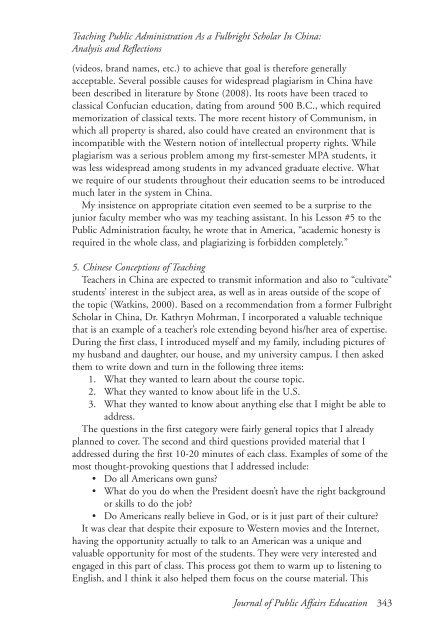journal of public affairs education - NASPAA *The Global Standard ...
journal of public affairs education - NASPAA *The Global Standard ...
journal of public affairs education - NASPAA *The Global Standard ...
- No tags were found...
Create successful ePaper yourself
Turn your PDF publications into a flip-book with our unique Google optimized e-Paper software.
Teaching Public Administration As a Fulbright Scholar In China:Analysis and Reflections(videos, brand names, etc.) to achieve that goal is therefore generallyacceptable. Several possible causes for widespread plagiarism in China havebeen described in literature by Stone (2008). Its roots have been traced toclassical Confucian <strong>education</strong>, dating from around 500 B.C., which requiredmemorization <strong>of</strong> classical texts. The more recent history <strong>of</strong> Communism, inwhich all property is shared, also could have created an environment that isincompatible with the Western notion <strong>of</strong> intellectual property rights. Whileplagiarism was a serious problem among my first-semester MPA students, itwas less widespread among students in my advanced graduate elective. Whatwe require <strong>of</strong> our students throughout their <strong>education</strong> seems to be introducedmuch later in the system in China.My insistence on appropriate citation even seemed to be a surprise to thejunior faculty member who was my teaching assistant. In his Lesson #5 to thePublic Administration faculty, he wrote that in America, “academic honesty isrequired in the whole class, and plagiarizing is forbidden completely.”5. Chinese Conceptions <strong>of</strong> TeachingTeachers in China are expected to transmit information and also to “cultivate”students’ interest in the subject area, as well as in areas outside <strong>of</strong> the scope <strong>of</strong>the topic (Watkins, 2000). Based on a recommendation from a former FulbrightScholar in China, Dr. Kathryn Mohrman, I incorporated a valuable techniquethat is an example <strong>of</strong> a teacher’s role extending beyond his/her area <strong>of</strong> expertise.During the first class, I introduced myself and my family, including pictures <strong>of</strong>my husband and daughter, our house, and my university campus. I then askedthem to write down and turn in the following three items:1. What they wanted to learn about the course topic.2. What they wanted to know about life in the U.S.3. What they wanted to know about anything else that I might be able toaddress.The questions in the first category were fairly general topics that I alreadyplanned to cover. The second and third questions provided material that Iaddressed during the first 10-20 minutes <strong>of</strong> each class. Examples <strong>of</strong> some <strong>of</strong> themost thought-provoking questions that I addressed include:• Do all Americans own guns?• What do you do when the President doesn’t have the right backgroundor skills to do the job?• Do Americans really believe in God, or is it just part <strong>of</strong> their culture?It was clear that despite their exposure to Western movies and the Internet,having the opportunity actually to talk to an American was a unique andvaluable opportunity for most <strong>of</strong> the students. They were very interested andengaged in this part <strong>of</strong> class. This process got them to warm up to listening toEnglish, and I think it also helped them focus on the course material. ThisJournal <strong>of</strong> Public Affairs Education 343
















